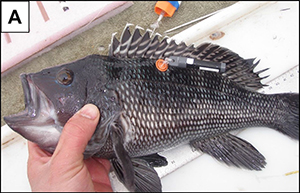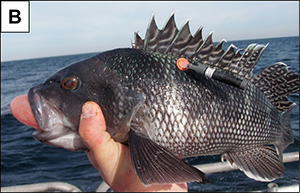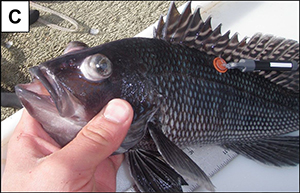Fact Sheet FS1337
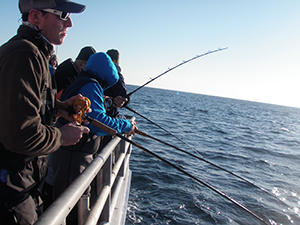
Figure 1. Recreational anglers fishing for black sea bass during the winter at a shipwreck off the coast of southern New Jersey (Photo credit: Douglas Zemeckis).
Black sea bass (Centropristis striata) are a favorite summertime catch of recreational anglers in New Jersey, given their excellent food quality and high abundance and catch rates around reefs and shipwrecks. Many anglers also catch black sea bass from late fall to early spring (Figure 1) when these fish migrate further offshore to overwinter in deeper waters. The objective of this fact sheet is to educate recreational anglers on the catch-and-release survival of black sea bass, with a focus on fish caught in deepwater (i.e., deeper than 100 feet) and performing a technique known as “swim bladder venting.”
Catch-And-Release Survival
Over seven million black sea bass are caught and released annually by recreational anglers in the Mid-Atlantic region (NMFS, 2018). Black sea bass are typically released to remain compliant with recreational fishing regulations such as minimum retention size, daily possession limits, or closed fishing seasons, but sometimes anglers simply release black sea bass because they do not wish to keep them. While catch-and-release is often considered a responsible conservation strategy, some released fish can die due to stress and injuries that occur from being hooked, fought for long periods of time, or spending too much time out of water. Therefore, to maximize the effectiveness of catch-and-release, it is important to understand why fish may die after release, to have reliable estimates of how many fish survive to inform fisheries management, and to educate anglers on best catch-and-release practices for increasing survival.
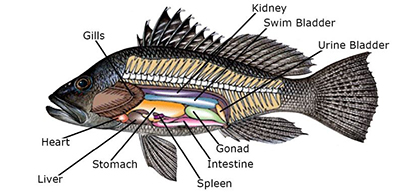
Figure 2. Internal anatomy of a black sea bass with the swim bladder shown in blue (Artwork produced by Anthony Vastano based on illustrations from Diane Rome Peebles and the Pennsylvania Fish and Boat Commission).
Fisheries management plans and stock assessments currently assume that 85% of black sea bass survive following catch-and-release by recreational anglers no matter how or where they are caught (NEFSC, 2017). However, research has shown that black sea bass catch-and-release survival can vary due to multiple factors, including geographic location or the depth from which fish are caught. For example, black sea bass catch-and-release survival was estimated to be 95% in 20–40 feet depths off Massachusetts (Bugley and Shepherd, 1991), 81% in 65–115 feet depths off North Carolina (Rudershausen et al., 2014), and 61% in 140–180 feet depths off South Carolina (Collins et al., 1999). We conducted a tagging study in 2016–2017 to better understand black sea bass catch-and-release survival in the deepwater (150 to 220 feet) winter fishery off the coast of New Jersey. The results of this study estimated that up to 51% of black sea bass die when caught and released in depths of around 150 feet. Our results also suggested that the survival rate might be even lower in fish caught at depths of 190 feet and 220 feet (Zemeckis et al., 2020).
Why Do Black Sea Bass Die After Release?
Black sea bass experience a reduction in pressure when they are reeled from the bottom of the ocean to the sea surface, which results in the expansion of the gases in their body. One of the places where the expansion of gas is most evident is in their swim bladder, which is an internal organ that regulates buoyancy and allows them to live normally at the bottom of the ocean (Figure 2).
Figure 3. Examples of tagged black sea bass that show (A) no external signs of barotrauma and those that do show external signs of barotrauma, including (B) stomach eversion and (C) exopthalmia (Photo credits: Douglas Zemeckis).
In comparison to a healthy fish (Figure 3A), gas expansion can fully inflate the swim bladder so that it takes up a lot of space in the body cavity and sometimes forces the stomach to protrude into the esophagus or out of the fish’s mouth, a phenomenon called stomach eversion (Figure 3B). Expanding gas in the fish’s eye also commonly causes exopthalmia, or “bug eyes” (Figure 3C), which can impair the fish’s vision. These types of pressure-related injuries are known as barotrauma and they can sometimes be severe enough to cause the fish to die. In our study off New Jersey, 95% of the black sea bass captured in 150–220 feet depths had their stomach everted and 10% had exopthalmia. Barotrauma was also determined to be the single biggest reason why fish did not survive after release in our study conducted during the winter off New Jersey (Zemeckis et al., 2020). Observations from other research and input from recreational anglers indicate that these barotrauma effects can occur in black sea bass that are captured in as shallow as 65 feet of water and they often increase in severity and frequency at deeper capture depths.
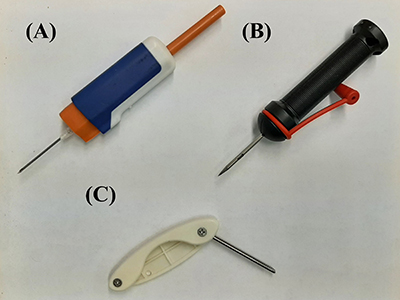
Figure 4. Examples of fish venting tools, including the (A) VentaFish™, (B) Angler’s Choice®, and (C) Ohero© fish venting tools.
How Can We Improve Black Sea Bass Survival?
One approach to reduce barotrauma effects and increase the catch-and-release survival of fish experiencing barotrauma is known as “swim bladder venting” (or, simply “venting”), which involves using a hypodermic needle to puncture the swim bladder and release the expanded gases. The intention of this action is to improve the ability of the fish to swim back to the ocean floor after being released at the sea surface, ultimately increasing the chances of their survival. This assistance can be necessary because some species of fishes frequently become too buoyant to swim back down to the bottom when experiencing barotrauma. Venting can also improve the ability of a fish to swim normally and avoid predators (other fish and birds), and recover from barotrauma or other injuries in its natural habitat at the ocean bottom.
Venting significantly increased the chance of catch-and-release survival of black sea bass captured in 150 feet of water off New Jersey during the winter. For instance, we found that the average survival rate of 51% for non-vented fish could be increased to 80% if their swim bladders were properly vented before being released (Zemeckis et al., 2020). To think of that in a different way, a black sea bass was approximately 2.5 times more likely to die if it wasn’t vented (i.e., 49% average mortality when non-vented, 20% average mortality when vented)! That’s a huge difference, especially considering that venting only takes a few seconds and can be performed using one of a variety of affordable venting tools (Figure 4).
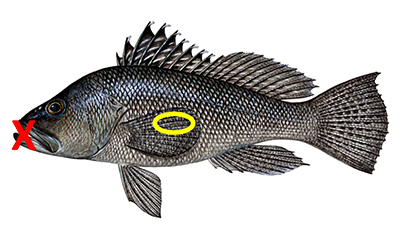
Figure 5. Image depicting the approximate location where the swim bladder would be located in a black sea bass experiencing barotrauma (i.e., behind the pectoral fin), which is the location (yellow ellipse) where venting should be performed. It is not recommended to puncture the stomach that is often everted out of the mouth (red "X") (Black sea bass artwork produced by Diane Rome Peebles).
How to Properly Vent a Black Sea Bass
Venting must be done using a proper technique to avoid further injuring the fish. To properly vent a black sea bass, the venting tool should be inserted right behind the pectoral fin given that the swim bladder is situated inside the fish’s body at this location (Figure 5). To deflate the swim bladder, the needle should be held at an approximately 45 degree angle relative to the fish’s body and then pushed in to pierce the skin and swim bladder (approximately a half inch depth for a black sea bass). It is important to note that swim bladders always remain inside the body of the fish, so if you see something in the fish’s mouth, then that is the stomach and not the swim bladder (Figure 3B)! Puncturing the stomach can itself cause fish to die, so fishermen should avoid using the venting tool to deflate the stomach.
Venting a black sea bass should be done quickly and safely for the benefit of both the angler and the fish! Ideally, the fish is placed on a flat surface such as a measuring board, filet table, or the top of a cooler in order to perform this procedure (Figure 6). However, if a flat surface is not available or conveniently located near an angler’s location on the boat, then the venting procedure could also be performed by the angler while standing at the rail and holding the fish in one hand and then venting the fish while using the tool with their other hand.
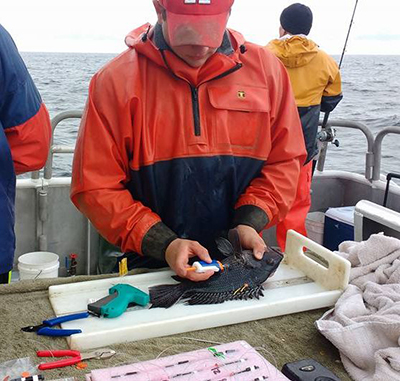
Figure 6. Marine agent Doug Zemeckis venting a black sea bass just before being tagged and released for research (Photo credit: Jeff Dement).
It is recommended that anglers also refer to the product packaging for further guidance on how to use their respective venting tool, because there are a variety of different tools available for venting fish (Figure 4). Additionally, a wide range of species could be vented, but for a smaller species such as black sea bass, we recommend selecting a venting tool with a thinner gauge (i.e., approximately 16 gauge) hypodermic needle to minimize the size of the hole created when puncturing the swim bladder.
The following steps should be followed when venting the swim bladder of a black sea bass that you intend to release:
What Else Can Increase Catch-and-Release Survival?
Our study during the winter off New Jersey determined that barotrauma and the inability to swim back to the bottom were the biggest factors that caused fish to die following catch-and-release. However, another notable factor affecting survival was the length of time in which fish were “fought,” or the time elapsed from hooking to being “landed” aboard the vessel, with longer fight times yielding lower survival rates. Therefore, it is also recommended that anglers reduce fight times when fishing for black sea bass to increase catch-and-release survival. This could be accomplished by fishing in as shallow of depths as possible, using appropriate strength tackle, considering how many hooks are used (i.e., “double header” catches can result in longer fight times), and reeling fish to the sea surface at a moderate pace.
Another alternative method for increasing the survival of black sea bass that experience barotrauma is to use a weighted descending device to release the fish at depth (i.e., at lower depths or at the seafloor) rather than at the sea surface. The premise behind a descending device is similar to venting in that it assists the fish in resubmerging to their preferred habitat, which increases the chance of survival. Ongoing research has shown that descending devices commonly improve the survival of snappers and groupers that also frequently experience barotrauma, so they may also work well with black sea bass.
The impacts of discards could be further mitigated by avoiding fishing in locations and seasons when black sea bass possession is prohibited and where the abundance of predators (e.g., bluefish, spiny dogfish) is highest to reduce predation on discarded fish. Additionally, avoiding the practice of high-grading, or discarding keeper-sized fish in hopes of catching even larger fish, could also reduce black sea bass discards and the number of fish that die after being caught and released.
Conclusion
Black sea bass are commonly caught and released by recreational anglers in New Jersey, including during colder months when they are found in deeper waters. Barotrauma effects reduce the catch-and-release survival of black sea bass in these deeper waters, but swim bladder venting, when done properly as instructed in this fact sheet, can significantly increase the survival of black sea bass that are released by recreational anglers. Additional angling practices, such as reducing fight times and avoiding fishing in locations and seasons with high discard rates (i.e., many small fish) or with abundant predators, could also help to increase catch-and-release survival and reduce the impacts of discards. Following these recommended catch-and-release practices will help to support the long-term sustainability of the black sea bass population and the fisheries for many more generations!
Further Reading
Additional Barotrauma and Swim Bladder Venting Guides for Other Species
Black Sea Bass Biology, Stock Assessment, and Fisheries Management Information
Acknowledgements
The authors wish to thank all the collaborating commercial fishermen and recreational anglers from Sea Isle City and Cape May, NJ who assisted with fieldwork, and the more than 40 volunteers who helped catch and tag fish as a part of the study conducted by Zemeckis et al. (2020), which was funded by the Mid-Atlantic Fishery Management Council’s Collaborative Research Program and entitled “Estimating and Mitigating the Discard Mortality Rate of Black Sea Bass in Offshore Recreational Rod-and-Reel Fisheries.” Additional scientific partners on that research project included Dr. John Mandelman (New England Aquarium), Dr. Olaf Jensen, Dr. Thomas Grothues (Rutgers University), Bill Hoffman, and Dr. Micah Dean (Massachusetts Division of Marine Fisheries).
References
- Bugley, K., and G. Shepherd. 1991. Management briefs: effects of catch-and-release angling on the survival of black sea bass. North Am. J. Fish. Manage. 11:468–471.
- Collins, M. R., J. C. McGovern, G. R. Sedberry, H. S. Meister, and R. Pardieck. 1999. Swim bladder deflation in black sea bass and vermilion snapper: potential for increasing postrelease survival. North Am. J. Fish. Manage. 19:828–832.
- National Marine Fisheries Service (NMFS). 2018. Fisheries Economics of the United States, 2016. U.S. Dept. of Commerce, NOAA Tech. Memo. NMFS-F/SPO-187, 243 p.
- Northeast Fisheries Science Center. 2017. 62nd Northeast Regional Stock Assessment Workshop (62nd SAW) Assessment Report. US Dept Commer, Northeast Fish Sci Cent Ref Doc. 17-03; 822 p. doi: 10.7289/V5/RD-NEFSC-17-03.
- Rudershausen, P. J., J. A. Buckel, and J. E. Hightower. 2014. Estimating reef fish discard mortality using surface and bottom tagging: effects of hook injury and barotrauma. Can. J. Fish. Aquat. Sci. 71:514–520.
- Zemeckis, D.R., J. Kneebone, C.W. Capizzano, E.A. Bochenek, W.S. Hoffman, T.M. Grothues, J.W. Mandelman, and O.P. Jensen. 2020. Discard mortality of black sea bass (Centropristis striata) in a deepwater recreational fishery off New Jersey: role of swim bladder venting in reducing mortality. Fishery Bulletin, 118: 105-119.
October 2021
Copyright © 2025 Rutgers, The State University of New Jersey. All rights reserved.
For more information: njaes.rutgers.edu.
Cooperating Agencies: Rutgers, The State University of New Jersey, U.S. Department of Agriculture, and Boards of County Commissioners. Rutgers Cooperative Extension, a unit of the Rutgers New Jersey Agricultural Experiment Station, is an equal opportunity program provider and employer.


